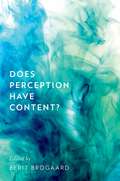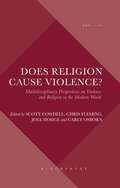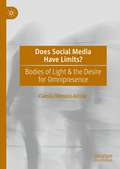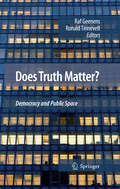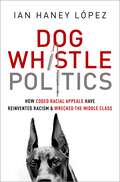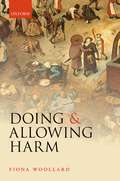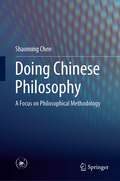- Table View
- List View
Does Neuroscience Have Normative Implications? (The International Library of Ethics, Law and Technology #22)
by Geoffrey S. Holtzman Elisabeth HildtThis book brings together a number of essays that are optimistic about the ways certain neuroscientific insights might advance philosophical ethics, and other essays that are more circumspect about the relevance of neuroscience to philosophical ethics. As a whole, the essays form a self-reflective body of work that simultaneously seeks to derive normative ethical implications from neuroscience, and to question whether and how that may be possible at all. In doing so, the collection brings together psychology, neuroscience, philosophy of mind, ethics, and philosophy of science. Neuroscience seeks to understand the biological systems that guide human behavior and cognition. Normative ethics, on the other hand, seeks to understand the system of abstract moral principles dictating how people ought to behave. By studying how the human brain makes moral judgments, can philosophers learn anything about the nature of morality itself? A growing number of researchers believe that neuroscience can, indeed, provide insights into the questions of philosophical ethics. However, even these advocates acknowledge that the path from neuroscientific is to normative ethical ought can be quite fraught.
Does Perception Have Content? (Philosophy of Mind)
Within the contemporary philosophical debates over the nature of perception, the question of whether perception has content in the first place recently has become a focus of discussion. The most common view is that it does, but a number of philosophers have questioned this claim. The issue immediately raises a number of related questions. What does it mean to say that perception has content? Does perception have more than one kind of content? Does perceptual content derive from the content of beliefs or judgments? Should perceptual content be understood in terms of accuracy conditions? Is naive realism compatible with holding that perception has content? This volume brings together philosophers representing many different perspectives to address these and other central questions in the philosophy of perception.
Does Religion Cause Violence?: Multidisciplinary Perspectives on Violence and Religion in the Modern World (Violence, Desire, and the Sacred)
by Scott Cowdell Chris Fleming Joel Hodge Carly OsbornOne of the most pressing issues of our time is the outbreak of extremist violence and terrorism, done in the name of religion. This volume critically analyses the link made between religion and violence in contemporary theory and proposes that 'religion' does not have a special relation to violence in opposition to culture, ideology or nationalism. Rather, religion and violence must be understood with relation to fundamental anthropological and philosophical categories such as culture, desire, disaster and rivalry.Does Religion Cause Violence? explores contemporary instances of religious violence, such as Islamist terrorism and radicalization in its various political, economic, religious, military and technological dimensions, as well as the legitimacy and efficacy of modern cultural mechanisms to contain violence, such as nuclear deterrence. Including perspectives from experts in theology, philosophy, terrorism studies, and Islamic studies, this volume brings together the insights of René Girard, the premier theorist of violence in the 20th century, with the latest scholarship on religion and violence, particularly exploring the nature of extremist violence.
Does Religion Cause Violence?: Multidisciplinary Perspectives on Violence and Religion in the Modern World (Violence, Desire, and the Sacred)
by Scott Cowdell Chris Fleming Joel Hodge Carly OsbornOne of the most pressing issues of our time is the outbreak of extremist violence and terrorism, done in the name of religion. This volume critically analyses the link made between religion and violence in contemporary theory and proposes that 'religion' does not have a special relation to violence in opposition to culture, ideology or nationalism. Rather, religion and violence must be understood with relation to fundamental anthropological and philosophical categories such as culture, desire, disaster and rivalry.Does Religion Cause Violence? explores contemporary instances of religious violence, such as Islamist terrorism and radicalization in its various political, economic, religious, military and technological dimensions, as well as the legitimacy and efficacy of modern cultural mechanisms to contain violence, such as nuclear deterrence. Including perspectives from experts in theology, philosophy, terrorism studies, and Islamic studies, this volume brings together the insights of René Girard, the premier theorist of violence in the 20th century, with the latest scholarship on religion and violence, particularly exploring the nature of extremist violence.
Does Social Media Have Limits?: Bodies of Light & the Desire for Omnipresence
by Camila Mozzini-AlisterThis book is a vibrant investigation on a deeply human subconscious desire: the desire for omnipresence, or in a nutshell, the desire to be here, there, and everywhere at the same time. After all, why is it not enough just to be in the offline ordinariness of the here and now? To answer this question, Camila Mozzini-Alister does the crossing of two seemingly distant universes: mediation and meditation. Throughout a vigorous archaeology of the relationship between screen and mind allied with an engaging first-person narrative, the author raises awareness of the risks of becoming addicted to social media and obsessed by meditation. This brings forth a vital question: what are the limits for the desire to be more than a body?
Does the Pro-Life Worldview Make Sense?: Abortion, Hell, and Violence Against Abortion Doctors (Routledge Research in Applied Ethics)
by Stephen KershnarThis book looks at a family of views involving the pro-life view of abortion and Christianity. These issues are important because major religious branches (for example, Catholicism and some large branches of Evangelicalism) and leading politicians assert, or are committed to, the following: (a) it is permissible to prevent some people from going to hell, (b) abortion prevents some people from going to hell, and (c) abortion is wrong. They also assert, or are committed to, the following: (d) it is permissible to use defensive violence to prevent people from killing innocents, (e) doctors who perform abortions kill innocents, and (f) it is wrong to use defensive violence against doctors who perform abortions. Stephen Kershnar argues that these and other principles are inconsistent. Along the way, he explores the ways in which theories of hell, right forfeiture, and good consequences relate to each other and the above inconsistencies.
Does the Pro-Life Worldview Make Sense?: Abortion, Hell, and Violence Against Abortion Doctors (Routledge Research in Applied Ethics)
by Stephen KershnarThis book looks at a family of views involving the pro-life view of abortion and Christianity. These issues are important because major religious branches (for example, Catholicism and some large branches of Evangelicalism) and leading politicians assert, or are committed to, the following: (a) it is permissible to prevent some people from going to hell, (b) abortion prevents some people from going to hell, and (c) abortion is wrong. They also assert, or are committed to, the following: (d) it is permissible to use defensive violence to prevent people from killing innocents, (e) doctors who perform abortions kill innocents, and (f) it is wrong to use defensive violence against doctors who perform abortions. Stephen Kershnar argues that these and other principles are inconsistent. Along the way, he explores the ways in which theories of hell, right forfeiture, and good consequences relate to each other and the above inconsistencies.
Does the U.S. Need a Truth and Reconciliation Commission?: A Philosophical Investigation
by Olúfẹ́mi TáíwòWritten from the perspective of a philosopher and African immigrant, this book makes a forceful moral argument for the need for a Truth and Reconciliation Commission (TRC) in the United States to address the long history of injustice to African-Americans. It shows that a TRC—similar to those established in South Africa and Chile—would rescue the ideals embodied in the U.S. Constitution while expanding their promise. Rejecting more recent views of the country’s founding as an embodiment of incorrigible racial oppression, Olúfẹmi Táíwò sees in the U.S. Constitution, and the original utopia that was at its foundation, the best available means for achieving liberty and justice. But he simultaneously shows how only a TRC can successfully open the path to moving the U.S. past its long legacy of anti-black racism in particular and racial oppression, generally, towards a more perfect union. Written with an immigrant’s love of his new homeland but a clear-eyed view of its major shortcomings, the book rejects the idea of American exceptionalism in prescribing a solution that has worked elsewhere. Key Features A clear view of the wide chasm between the ideals established at the U.S.’s founding and the subsequent society that developed. Combines first-person experiences of the author with close readings of modern political philosophy, W.E.B. Du Bois, Martin Luther King, Jr., Derrick Bell, and others. Traces the link between the denial of citizenship to Blacks, both historically and today, and anti-Black violence. Shows how an obsession with the law and legal reform will never adequately address the fundamental problem of anti-Black oppression. Shows philosophically the necessity of establishing a consensual view of the truth, and how it must precede any effective reconciliation.
Does the U.S. Need a Truth and Reconciliation Commission?: A Philosophical Investigation
by Olúfẹ́mi TáíwòWritten from the perspective of a philosopher and African immigrant, this book makes a forceful moral argument for the need for a Truth and Reconciliation Commission (TRC) in the United States to address the long history of injustice to African-Americans. It shows that a TRC—similar to those established in South Africa and Chile—would rescue the ideals embodied in the U.S. Constitution while expanding their promise. Rejecting more recent views of the country’s founding as an embodiment of incorrigible racial oppression, Olúfẹmi Táíwò sees in the U.S. Constitution, and the original utopia that was at its foundation, the best available means for achieving liberty and justice. But he simultaneously shows how only a TRC can successfully open the path to moving the U.S. past its long legacy of anti-black racism in particular and racial oppression, generally, towards a more perfect union. Written with an immigrant’s love of his new homeland but a clear-eyed view of its major shortcomings, the book rejects the idea of American exceptionalism in prescribing a solution that has worked elsewhere. Key Features A clear view of the wide chasm between the ideals established at the U.S.’s founding and the subsequent society that developed. Combines first-person experiences of the author with close readings of modern political philosophy, W.E.B. Du Bois, Martin Luther King, Jr., Derrick Bell, and others. Traces the link between the denial of citizenship to Blacks, both historically and today, and anti-Black violence. Shows how an obsession with the law and legal reform will never adequately address the fundamental problem of anti-Black oppression. Shows philosophically the necessity of establishing a consensual view of the truth, and how it must precede any effective reconciliation.
Does the World Exist?: Plurisignificant Ciphering of Reality (Analecta Husserliana #79)
by Anna-Teresa Tymieniecka"Does the World exist?" There would be no reason to resurrect this question of modernity from its historical oblivion were it not for the fact that recent evolution in science and technology, impregnating culture, makes us wonder about the nature of reality, of the world we are living in, and of our status as living beings within it. Thus great metaphysical subjacent queries are forcefully revived, calling for new investigations to proceed in the light of the innumerable novel insights of science. This collection presents a wealth of material toward an elaboration of a new metaphysical groundwork of the ontopoiesis/ phenomenology of life sought to effect such investigations. The classic postulates of the metaphysics of reality, those of necessity and certainty here find a new formulation. Away from sclerotized ontological and cognitive assumptions and congenial with the views of contemporary science, the understanding of reality, of our world of life, and of ourselves within it is to be sought in the existential/ontopoietic ciphering of life (Tymieniecka).
Does Tomorrow Exist?: A Debate (Little Debates about Big Questions)
by Nikk Effingham Kristie MillerThis book takes up the question of whether past and future events exist. Two very different views are explored. According to one of these views (presentism), advanced by Nikk Effingham, the present is special. Effingham argues that only present things exist, but which things those are changes as time passes. Given presentism, although there once existed dinosaurs, they exist no more, and although you and I exist, at some time in the future we will come to exist no more. According to the alternative view (eternalism), advanced by Kristie Miller, our world is a giant four-dimensional block of spacetime in which all things, past, present, and future, exist. On this view, dinosaurs exist, it is just that they are not located at the current time. The book considers arguments for and against presentism and eternalism, including arguments that appeal to our best science, to the way the world seems to us to be in our experiences of time, change, and freedom, and to how to make sense of ordinary claims about the past. Key Features: Offers an accessible introduction to the philosophy of temporal ontology. Captures the process of philosophical debate, giving readers an insight into the craft of philosophy. Engages with and clearly explains state-of-the-art and cutting-edge research.
Does Tomorrow Exist?: A Debate (Little Debates about Big Questions)
by Nikk Effingham Kristie MillerThis book takes up the question of whether past and future events exist. Two very different views are explored. According to one of these views (presentism), advanced by Nikk Effingham, the present is special. Effingham argues that only present things exist, but which things those are changes as time passes. Given presentism, although there once existed dinosaurs, they exist no more, and although you and I exist, at some time in the future we will come to exist no more. According to the alternative view (eternalism), advanced by Kristie Miller, our world is a giant four-dimensional block of spacetime in which all things, past, present, and future, exist. On this view, dinosaurs exist, it is just that they are not located at the current time. The book considers arguments for and against presentism and eternalism, including arguments that appeal to our best science, to the way the world seems to us to be in our experiences of time, change, and freedom, and to how to make sense of ordinary claims about the past. Key Features: Offers an accessible introduction to the philosophy of temporal ontology. Captures the process of philosophical debate, giving readers an insight into the craft of philosophy. Engages with and clearly explains state-of-the-art and cutting-edge research.
Does Truth Matter?: Democracy and Public Space
by Ronald Tinnevelt Raf GeenensThe claim once made by philosophers of unique knowledge of the essence of humanity and society has fallen into disrepute. Neither Platonic forms, divine revelation nor metaphysical truth can serve as the ground for legitimating social and political norms. On the political level many seem to agree that democracy doesn’t need foundations. Nor are its citizens expected to discuss the worth of their comprehensive conceptions of the good life. According to Rawls, for example, we have to accept that “politics in a democratic society can never be guided by what we see as the whole truth (…)”. (1993: 243) And yet we still call upon truth when we participate in defining the basic structure our society and argue why our opinions, beliefs and preferences need to be taken seriously. We do not think that our views need to be taken into account by others because they are our views, but because we think they are true. If in a democratic society citizens have to deal with the challenge of affirming their claims as true, we need to analyse the precise relationship between truth and democracy. Does truth matter to democracy and if so, what is the place of truth in democratic politics? How can citizens affirm the truth of their claims and accept - at the same time - that their truth is just one amongst many? Our book centers on the role of the public sphere in these pressing questions. It tries to give a comprehensive answer to these questions from the perspective of the main approaches of contemporary democratic theory: deliberative democracy, political pragmatism and liberalism. A confrontation of these approaches, will result in a more encompassing philosophical understanding of our plural democracy, which – in this era of globalization – is more complex than ever before. Because a good understanding of the function, meaning and shortcomings of the public sphere is essential to answering these questions, a good deal of the book addresses these issues. Historically, after all, the idea that citizens have to engage each other in discussion in order to determine the structure and goals of society, is connected to the rational ideal of a public sphere where conflicting views can be expressed, formed, and transformed. But hasn’t the collective decision making in which everyone participates on an equal footing turned out to be a deceptive ideal or a simple illusion? Not every individual in society has equal access to the podium. Furthermore, power, being an inevitable feature of the public sphere, seems to permanently endanger its democratic value. Moreover, the existence of this sphere depends on a specific ethos and particular public spaces where citizens are called upon to present themselves as citizens, as people taking responsibility for their society. It is not clear whether this ethos and these spaces exist at all, and if so, if they preserved their ascribed capacity for constituting ‘democratic’ truth? By answering these questions we expect to deepen our understanding of the relation between truth and democracy.
The Dog Allusion: Pets, Gods and How to be Human
by Martin Rowson'As with dogs, so with gods - by and large, you should blame the owners.'A particular trait, common to all human civilisations, is the worship of non-human entities with followings of devotees who claim that their reverence can transport them to transcendental heights of complete and unfettered love.Do we mean God? No - we mean Dog. Dogs and other pets we've been keeping and loving since we began walking on two feet. But why do we love God - and pets - so much when their capriciousness sometimes suggests that they don't love us back?In this wise, witty and highly topical book, celebrated cartoonist and novelist Martin Rowson argues that rationally, the whole enterprise of religion is a monumental and faintly ridiculous waste of time and money. But then again, so is pet-keeping.
Dog Whistle Politics: How Coded Racial Appeals Have Reinvented Racism and Wrecked the Middle Class
by Ian Haney LópezCampaigning for president in 1980, Ronald Reagan told stories of Cadillac-driving "welfare queens" and "strapping young bucks" buying T-bone steaks with food stamps. In trumpeting these tales of welfare run amok, Reagan never needed to mention race, because he was blowing a dog whistle: sending a message about racial minorities inaudible on one level, but clearly heard on another. In doing so, he tapped into a long political tradition that started with George Wallace and Richard Nixon, and is more relevant than ever in the age of the Tea Party and the first black president. In Dog Whistle Politics, Ian Haney López offers a sweeping account of how politicians and plutocrats deploy veiled racial appeals to persuade white voters to support policies that favor the extremely rich yet threaten their own interests. Dog whistle appeals generate middle-class enthusiasm for political candidates who promise to crack down on crime, curb undocumented immigration, and protect the heartland against Islamic infiltration, but ultimately vote to slash taxes for the rich, give corporations regulatory control over industry and financial markets, and aggressively curtail social services. White voters, convinced by powerful interests that minorities are their true enemies, fail to see the connection between the political agendas they support and the surging wealth inequality that takes an increasing toll on their lives. The tactic continues at full force, with the Republican Party using racial provocations to drum up enthusiasm for weakening unions and public pensions, defunding public schools, and opposing health care reform. Rejecting any simple story of malevolent and obvious racism, Haney López links as never before the two central themes that dominate American politics today: the decline of the middle class and the Republican Party's increasing reliance on white voters. Dog Whistle Politics will generate a lively and much-needed debate about how racial politics has destabilized the American middle class-white and nonwhite members alike.
Dog Whistle Politics: How Coded Racial Appeals Have Reinvented Racism and Wrecked the Middle Class
by Ian Haney LópezCampaigning for president in 1980, Ronald Reagan told stories of Cadillac-driving "welfare queens" and "strapping young bucks" buying T-bone steaks with food stamps. In trumpeting these tales of welfare run amok, Reagan never needed to mention race, because he was blowing a dog whistle: sending a message about racial minorities inaudible on one level, but clearly heard on another. In doing so, he tapped into a long political tradition that started with George Wallace and Richard Nixon, and is more relevant than ever in the age of the Tea Party and the first black president. In Dog Whistle Politics, Ian Haney López offers a sweeping account of how politicians and plutocrats deploy veiled racial appeals to persuade white voters to support policies that favor the extremely rich yet threaten their own interests. Dog whistle appeals generate middle-class enthusiasm for political candidates who promise to crack down on crime, curb undocumented immigration, and protect the heartland against Islamic infiltration, but ultimately vote to slash taxes for the rich, give corporations regulatory control over industry and financial markets, and aggressively curtail social services. White voters, convinced by powerful interests that minorities are their true enemies, fail to see the connection between the political agendas they support and the surging wealth inequality that takes an increasing toll on their lives. The tactic continues at full force, with the Republican Party using racial provocations to drum up enthusiasm for weakening unions and public pensions, defunding public schools, and opposing health care reform. Rejecting any simple story of malevolent and obvious racism, Haney López links as never before the two central themes that dominate American politics today: the decline of the middle class and the Republican Party's increasing reliance on white voters. Dog Whistle Politics will generate a lively and much-needed debate about how racial politics has destabilized the American middle class-white and nonwhite members alike.
Dogen and Soto Zen
by Steven HeineDogen and Soto Zen builds upon and further refines a continuing wave of enthusiastic popular interest and scholarly developments in Western appropriations of Zen. In the last few decades, research in English and European languages on Dogen and Soto Zen has grown, aided by an increasing awareness on both sides of the Pacific of the important influence of the religious movement and its founder. The school has flourished throughout the medieval and early modern periods of Japanese history, and it is still spreading and reshaping itself in the current age of globalization. This volume continues the work of Steven Heine's recently published collection, Dogen: Textual and Historical Studies, featuring some of the same outstanding authors as well as some new experts who explore diverse aspects of the life and teachings of Zen master Dogen (1200-1253), the founder of the Soto Zen sect (or Sotoshu) in early Kamakura-era Japan. The contributors examine the ritual and institutional history of the Soto school, including the role of the Eiheji monastery established by Dogen as well as rites and precepts performed there and at other temples.
Dogen and Soto Zen
by Steven HeineDogen and Soto Zen builds upon and further refines a continuing wave of enthusiastic popular interest and scholarly developments in Western appropriations of Zen. In the last few decades, research in English and European languages on Dogen and Soto Zen has grown, aided by an increasing awareness on both sides of the Pacific of the important influence of the religious movement and its founder. The school has flourished throughout the medieval and early modern periods of Japanese history, and it is still spreading and reshaping itself in the current age of globalization. This volume continues the work of Steven Heine's recently published collection, Dogen: Textual and Historical Studies, featuring some of the same outstanding authors as well as some new experts who explore diverse aspects of the life and teachings of Zen master Dogen (1200-1253), the founder of the Soto Zen sect (or Sotoshu) in early Kamakura-era Japan. The contributors examine the ritual and institutional history of the Soto school, including the role of the Eiheji monastery established by Dogen as well as rites and precepts performed there and at other temples.
Dogwhistles and Figleaves: How Manipulative Language Spreads Racism and Falsehood
by Jennifer Mather SaulPinpoints how "dogwhistles" and "figleaves," two kinds of linguistic trick, distort political discourse and normalize racism It is widely accepted that political discourse in recent years has become more openly racist and more accepting of wildly implausible conspiracy theories. Dogwhistles and Figleaves explores ways in which such changes—both of which defied previously settled norms of political speech—have been brought about. Jennifer Saul shows that two linguistic devices, dogwhistles and figleaves, have played a crucial role. Some dogwhistles (such as "88", used by Nazis online to mean "Heil Hitler") serve to disguise messages that would otherwise be rejected as unacceptable, allowing them to be transmitted surreptitiously. Other dogwhistles (like the 1988 "Willie Horton" ad) work by influencing people in ways that they are not aware of, and which they would likely reject were they aware. Figleaves (such as "just asking questions") take messages that could easily be recognized as unacceptable, and provide just enough cover that people become more willing to accept them. Saul argues that these devices are important for the spread of racist discourse. She also shows how they contribute to the transmission of norm-violating discourse more generally, focusing on the case of wildly implausible conspiracist speech. Together, these devices have both exploited and widened existing divisions in society, and normalized racist and conspiracist speech. This book is the first full-length exploration of dogwhistles and figleaves. It offers an illuminating and disturbing view of the workings of contemporary political discourse.
Dogwhistles and Figleaves: How Manipulative Language Spreads Racism and Falsehood
by Jennifer Mather SaulPinpoints how "dogwhistles" and "figleaves," two kinds of linguistic trick, distort political discourse and normalize racism It is widely accepted that political discourse in recent years has become more openly racist and more accepting of wildly implausible conspiracy theories. Dogwhistles and Figleaves explores ways in which such changes—both of which defied previously settled norms of political speech—have been brought about. Jennifer Saul shows that two linguistic devices, dogwhistles and figleaves, have played a crucial role. Some dogwhistles (such as "88", used by Nazis online to mean "Heil Hitler") serve to disguise messages that would otherwise be rejected as unacceptable, allowing them to be transmitted surreptitiously. Other dogwhistles (like the 1988 "Willie Horton" ad) work by influencing people in ways that they are not aware of, and which they would likely reject were they aware. Figleaves (such as "just asking questions") take messages that could easily be recognized as unacceptable, and provide just enough cover that people become more willing to accept them. Saul argues that these devices are important for the spread of racist discourse. She also shows how they contribute to the transmission of norm-violating discourse more generally, focusing on the case of wildly implausible conspiracist speech. Together, these devices have both exploited and widened existing divisions in society, and normalized racist and conspiracist speech. This book is the first full-length exploration of dogwhistles and figleaves. It offers an illuminating and disturbing view of the workings of contemporary political discourse.
Doing and Allowing Harm
by Fiona WoollardDoing harm seems much harder to justify than merely allowing harm. If a boulder is rushing towards Bob, you may refuse to save Bob's life by driving your car into the path of the boulder if doing so would cost you your own life. You may not push the boulder towards Bob to save your own life. This principle—the Doctrine of Doing and Allowing—requires defence. Does the distinction between doing and allowing fall apart under scrutiny? When lives are at stake, how can it matter whether harm is done or allowed? Drawing on detailed analysis of the distinction between doing and allowing, Fiona Woollard argues that the Doctrine of Doing and Allowing is best understood as a principle that protects us from harmful imposition. Such protection against imposition is necessary for morality to recognize anything as genuinely belonging to a person, even that person's own body. As morality must recognize each person's body as belonging to her, the Doctrine of Doing and Allowing should be accepted. Woollard defends a moderate account of our obligations to aid, tackling arguments by Peter Singer and Peter Unger that we must give most of our money away and arguments from Robert Nozick that obligations to aid are incompatible with self-ownership.
Doing Austin Justice: The Reception of John Austin's Philosophy of Law in Nineteenth Century England (Continuum Studies in British Philosophy)
by Wilfrid RumbleAustin was an towering presence in 19th-century English jurisprudence, and many of his ideas remain viable today. They include his conception of analytical jurisprudence, his sharp distinction between law and morality, and his utilitarian theory of resistance to government. Yet he has always had his critics and they have become ever shriller in the last 50 years. If it is not a requirement of political correctness to belittle his ideas, the tendency to do so is widespread. Critics often dismiss Austin with a wave of the hand, or reduce his jurisprudence to a few of his ideas, such as his conception of law as a command or his notion of a legally unlimited sovereign. Whatever approach is taken, Austin's doctrines tend to be abstracted from their historical context and vastly oversimplified. For example, the utilitarian ethical theories that he expounded in three of the six chapters of the only book that he published in his lifetime are usually ignored. Accordingly, there has been a failure to recognize the complexity and inner tensions of his legal philosophy. There is not one John Austin, but at least half-a-dozen. Nothing makes this clearer than the diverse responses to his work in the 19th century. Wilfrid E. Rumble's study thus fills a large gap in the literature about this important figure. It will be of substantial interest not only to historians of ideas, law, and the 19th century, but also to jurists, legal philosophers, and political theorists.
Doing Chinese Philosophy: A Focus on Philosophical Methodology
by Shaoming ChenThis book focuses on "doing Chinese philosophy", the concept of which is a derivative form of Ludwig Wittgenstein's expression "doing philosophy". On the one hand, its approach differs from the traditional philosophical study method, which tends to discuss rather than do; on the other, it focuses on the unique features of Chinese philosophy. The concept of "Chinese philosophy" combines classical philosophy and contemporary philosophy. Whether classical Chinese philosophy still holds power depends on its ability to compete with contemporary philosophies (from the West, or ideology). At the very least, it has to convincingly show that classical thought has a unique role in interpreting and shaping the function of modern spiritual culture. Providing insights into China's excellent philosophical ideas, this book will appeal to all readers who have a basic understanding of philosophy and are interested in Chinese philosophical thought. It not only explains the author's proposal for studying Chinese philosophy in terms of methodology, but also answers the question of how classic Chinese works should influence other cultures.
Doing Clinical Ethics: A Hands-on Guide for Clinicians and Others (SpringerBriefs in Ethics)
by Daniel K. SokolIn this Brief, Daniel Sokol interprets ‘doing medical ethics’ broadly to capture the application of ethical knowledge to a concrete situation, rather than just resolving a moral dilemma contained within a case. It instructs clinicians on how to identify and analyse a clinical ethics case, and guides the reader in publishing in general medical, specialist medical, and medical ethics journals, and through presenting on ethical issues at conferences. In addition to this, advice on how to teach medical ethics, and apply for research ethics approval, is included. “…an admirably short and clear guide to doing medical ethics… I welcome this book and urge medical students and doctors of all grades to read it in paper, on-line or on your portable screen reader.” Sir Richard Thompson, President of the Royal College of Physicians, UK “Dr. Sokol has provided the field with a much needed, easy and comprehensive tool on 'doing' clinical ethics that all should have in their back pockets.” Dr. Nneka Mokwunye, Director of Bioethics, Washington Hospital Center, Washington DC, USA “This is a magnificent guide to clinical ethics and reflects the author’s very well known and widely respected academic gravitas and real life experience in clinical ethics. It is a “must read” for anyone involved in the field.” Mr. Vassilios Papalois, Consultant Surgeon and Chairman, Imperial College Healthcare NHS Trust Clinical Ethics Committee, UK
Doing Diaspora: Ethnonationale Homogenisierung im transnationalen Bildungsraum der Tamil Diaspora
by Thusinta SomalingamThusinta Somalingam bietet in der vorliegenden Studie eine neue Perspektive auf den Bereich Bildung, die sich von nationalstaatlichen Orientierungen löst und ihren Blick auf grenzüberschreitende Bildungsarbeit richtet. Auf der Grundlage eines vielfältigen empirischen Datensatzes erarbeitet die Autorin anhand des Fallbeispiels der Tamil Diaspora, dass transnationale (Bildungs-)Räume nicht zwangsläufig national(staatliche) Aspekte wie Sprach- und Nationalbewusstsein relativieren, sondern durchaus auch zur Verstärkung und Rekonstruktion bestehender nationaler Strukturen und Tendenzen beitragen können. Die Arbeit von Thusinta Somalingam gibt neue Impulse zur Erforschung von grenzüberschreitenden Bildungsräumen und bietet neue Perspektiven für die Transnationalitäts- sowie die Diasporaforschung.

